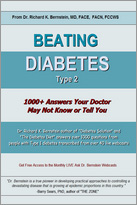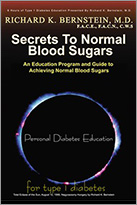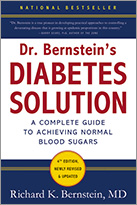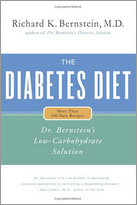“Big inputs make big mistakes; small inputs make small mistakes.”
That is the first thing my friend Kanji Ishikawa says to himself each morning on arising. It is his mantra, the single most important thing he knows about diabetes.
Kanji is the oldest surviving type 1 diabetic in Japan (he is, by the way, younger than I, but afflicted with numerous long-term diabetic complications because of many years of uncontrolled blood sugars). Many biological and mechanical systems respond in a predictable way to small inputs but in a chaotic and considerably less predictable way to large inputs. Consider for a moment traffic. Put a small number of automobiles on a given stretch of highway and traffic acts in a predictable fashion: cars can maintain speed, enter and merge into open spaces, and exit with a minimum of danger. There’s room for error. Double the number of cars and the risks don’t just double, they increase geometrically. Triple or quadruple the number of cars and the unpredictability of a safe trip increases exponentially.
The name of the game for the diabetic in achieving blood sugar normalization is predictability. It’s very difficult to use medications safely unless you can predict the effect they’ll have. Nor can you normalize blood sugar unless you can predict the effects of what you’re eating. If you can’t accurately predict your blood sugar levels, then you can’t accurately predict your needs for insulin or oral blood sugar–lowering agents. If the kinds of foods you’re eating give you consistently unpredictable blood sugar levels, then it will be impossible to normalize blood sugars.
One of the prime intents of this book is to give you the information you need to learn how to predict your blood sugar levels and how to ensure that your predictions will be accurate. Here the Laws of Small Numbers are exceedingly important.
Predictability. How do you achieve it?
THE LAW OF CARBOHYDRATE ESTIMATION
The old American Diabetes Association (ADA) dietary recommendations allowed 150 grams of carbohydrate per meal. This, as you may know by now, is grossly excessive for people trying to control their blood sugars. Here is one reason why.
Typically, 150 grams of carbohydrate would be a good-sized bowl of cooked pasta. You may think that by reading the ingredients label on the package you can precisely compute how much of the dry pasta you must weigh out to dispense exactly 150 grams of carbohydrate. Now, if you’re a nonobese type 1 diabetic who weighs 150 pounds (68 kilograms) and makes no insulin, 1 gram of carbohydrate will raise your blood sugar by about 5 mg/dl. By using methods that we’ll later describe, you can calculate exactly how much insulin you must inject to keep your blood sugar at the same point after the meal as it was before the meal. This may sound elegant, but it will rarely work for a highcarbohydrate meal. What neither the ADA nor the package tells you is that food producers are permitted a margin of error of plus or minus 20 percent in their labeling of ingredients. Furthermore, many packaged products—for example vegetable soup—cannot even match this error range, in spite of federal labeling requirements. So even if you perform the necessary calculations, your blood sugar after the meal can be off by a carbohydrate error of 5 mg/dl multiplied by ± 30 grams (± 20 percent of 150 gm), or by a whopping ±150 mg/dl for just this one meal. If your target blood sugar level is approximately 85 mg/ dl, you’ve now got a blood glucose level anywhere between 235 mg/dl and 0 mg/dl. Either situation is clearly unacceptable.
Let’s try another example. Say you’re a type 2 diabetic, obese, and make some insulin of your own but also inject insulin. You’ve found that 1 gram of carbohydrate only raises your blood sugar by 3 mg/dl. Your blood sugar would be off by ±90 mg/dl. If your target blood sugar value is, say, 90 mg/dl, you’re looking at a postmeal blood sugar level of anywhere from 180 mg/dl to 0 mg/dl.
That’s one of the many problems with the ADA guidelines. Big inputs and big uncertainty.
But if you eat an amount of carbohydrate that will affect your blood sugar by one-tenth of that margin of error, then you’re going to have a much simpler time of normalizing blood sugar levels. My diet plan, which we will get into in Chapters 9–11, aims to keep these margins in the realm of ±10–20 mg/dl. How do we accomplish this? Small inputs. Eating only a tenth of a serving of pasta is not the answer. Even small amounts of some carbohydrates can cause big swings in blood sugar. And anyway, who would feel satisfied after such a small serving of pasta? The key is to eat foods that will affect your blood sugar in a very small way.
Small inputs, small mistakes. Sounds so simple and straightforward that it may make you want to ask why no one has told you about it before. Say that instead of eating pasta as the carbohydrate portion of your meal, you eat salad. If you estimate 2 cups of salad to total 12 grams of carbohydrate and are off not by 20 percent but by 30 percent, that’s still an uncertainty of only 4 grams of carbohydrate—a maximum potential 20 mg/dl rise or fall in blood sugar. A big bowl of pasta for a couple of cups of salad? Not much of a trade, you may say. Well, we don’t intend that you starve. As you decrease the amount of fast-acting carbohydrate you eat, you can often simultaneously increase the amount of protein you eat. Protein can, as you may recall, also cause a blood sugar rise, but this takes place much more slowly, to a much smaller degree, and is more easily covered with medication.
In theory, you could weigh everything you eat right down to the last gram and make your calculations based on information provided by the manufacturer or derived from some of the books we use. This information, as noted above, is only an estimate, with considerable margin for error. You will have only a vague idea of what you’re actually consuming, and of the effect it will have on blood sugar.
The idea here is to stick with low levels of slow-acting, nutritious carbohydrates. In addition, stick with foods that will make you feel satisfied without causing huge swings in blood sugar. Simple.
THE LAW OF INSULIN DOSE ABSORPTION
If you do not take insulin, you can skip this section.
Think again of traffic. You’re driving down the road and your car drifts slightly toward the median. To bring it back into line, you make a slight adjustment of the steering wheel. No problem. But yank the steering wheel and it could carry you into another lane, or could send you careening off the road.
When you inject insulin, not all of it reaches your bloodstream. Research has shown that there’s a level of uncertainty as to just how much absorption of insulin actually takes place. The more insulin you use, the greater the level of uncertainty.
When you inject insulin, you’re putting beneath your skin a substance that isn’t, according to your immune system’s way of seeing things, supposed to be there. So a portion of it will be destroyed as a foreign substance before it can reach the bloodstream. The amount that the body can destroy depends on several factors. First is how big a dose you inject. The bigger the dose, the more inflammation and irritation you cause, and the more of a “red flag” you send up to your immune system. Other factors include the depth, speed, and location of
your injection.
Your injections will naturally vary from one time to the next. Even the most fastidious person will unconsciously alter minor things in the injection process from day to day. So the amount of insulin that gets into your bloodstream is always going to have some variability. The bigger the dose, the bigger the variation.
A number of years ago, researchers at the University of Minnesota demonstrated that if you inject about 20 units of insulin into your arm, you’ll get on average a 39 percent variation in the amount that makes it into the bloodstream from one day to the next. They found that abdominal injections had only a 29 percent average variation, and so recommended that we use only abdominal injections. On paper that seems fine, but in practice the effects on blood sugar are still intolerable. Say you do inject 20 units of insulin at one time. Each unit lowers the blood sugar of a typical 150-pound adult by 40 mg/dl. A 29 percent variability will create a 7-unit discrepancy in your 20-unit injection, which means a 280 mg/dl blood sugar uncertainty (40 mg/dl x 7 units). The result is totally haphazard blood sugars and complete unpredictability, just by virtue of the varying amounts of insulin absorbed. Research and my own experience demonstrate that the smaller your dose of insulin, the less variability you get. For type 1 diabetics who are not obese, we’d ideally like to see doses anywhere from ¼ unit to 6 units or at the most 7. Typically, you might take 3–5 units in a shot. At these lower doses, the uncertainty of absorption approaches zero, so that there is no need to worry about whether you should inject in your arm or abdomen or elsewhere.
I have a very obese patient who requires 27 units of long-acting insulin at bedtime. He’s so insulin-resistant that there’s no way to keep his blood sugar under control without this massive dose. In order to ameliorate the unpredictability of large doses, he splits his bedtime insulin into four small shots given into four separate sites using the same disposable syringe. As a rule, I recommend that a single insulin injection never exceed 7 units.
THE LAW OF INSULIN TIMING
Again, it’s very difficult to use any medication safely unless you can predict the effect it will have. With insulin, this is as true of when you inject as it is of how much you take. If you’re a type 1 diabetic, fastacting (regular) insulin can be injected 40–45 minutes prior to a meal tailored to your diet plan to prevent the ensuing rise in blood sugar. Regular, “fast-acting” insulin, despite its designation, doesn’t act very fast, and cannot come close to approximating the phase I insulin response of a nondiabetic. To a lesser degree this is also true of the new, faster-acting lispro (Humalog) or aspart (Novolog) insulins. Still, these are the fastest we have. Small doses of regular start to work in about 45 minutes and do not finish for at least 5 hours; lispro starts to work in about 20 minutes and also takes at least 5 hours to finish. This is considerably slower than the speed at which fast-acting carbohydrate raises blood sugar.
Many years ago, John Galloway, then medical director of Eli Lilly and Company, performed an eye-opening experiment. He gave one injection of 70 units of regular insulin (a very large dose) to a nondiabetic volunteer who was connected to an intravenous glucose infusion.
Dr. Galloway then measured blood sugars every few minutes and adjusted the glucose drip to keep the patient’s blood sugars clamped at 90 mg/dl. How long would you guess the glucose infusion had to be continued to prevent dangerously low blood sugars, or hypoglycemia?
It took a week, even though the package insert says that regular insulin lasts only 4–12 hours. So the conclusion is that even the timing of injected insulin is very much dependent upon how much was injected. In practice, larger insulin injections start working sooner, last longer, and have less predictable timing.
If you eat a meal not specifically tailored to our restricted-carbohydrate diet and try to cover it with insulin, you’ll get a postprandial (after-eating) increase in blood sugar, eventually followed by a decrease as the fast-acting insulin catches up. This means that you’ll have high blood sugars after every meal, and you could still fall prey to the long-term complications of diabetes. If you try to prevent the inevitable postprandial blood sugar spike by waiting to eat until after the start time of your insulin, you may easily make yourself hypoglycemic, which could in turn cause you to overcompensate by overeating— that is, presuming you don’t lose consciousness first.
Type 2 diabetics have a diminished or absent phase I insulin response, and so they face a problem similar to that of type 1s. They have to wait hours for the phase II insulin to catch up if they eat fast-acting carbohydrate or large amounts of slow-acting carbohydrate.
The key to timing insulin injections is to know how carbohydrates and insulin affect your blood sugar and to use that knowledge to minimize the swings. Since you can’t approximate phase I insulin response, you have to eat foods that allow you to work within the limits of the insulin you make or inject. If you think you’ll miss out on the great high-carbohydrate, low-fat diet recommended by the ADA— which, if you look at the statistics, has only succeeded in raising levels of obesity, elevating triglycerides and LDL, and causing an epidemic of diabetes—there is considerable evidence that restricting carbohydrate is healthier not only for diabetics but for everyone. (For more details on this point, see Protein Power, by Drs.Michael and Mary Dan Eades, Bantam Books, 1996; or go to www.diabetes-book.com and, under “Articles,” read “What If It’s All Been a Big Fat Lie?” by Gary Taubes.)
If you consume only small amounts of slow-acting carbohydrate, you can actually prevent postprandial blood sugar elevation with injected preprandial rapid-acting insulin. In fact, by restricting carbohydrate intake, many type 2 diabetics will be able to prevent this rise with their phase II insulin response and will not need injected insulin before meals.
OBEYING THE LAWS OF SMALL NUMBERS
Essential to obeying the Laws of Small Numbers is to eat only small amounts of slow-acting carbohydrate when you eat carbohydrate, and no fast-acting carbohydrate. Even the slowest-acting carbohydrate can outpace injected or phase II insulin if consumed in greater amounts than recommended later in this book (Chapters 9–11).
If you eat a small amount of slow-acting carbohydrate, you might get by with a very small or no postprandial blood sugar increase. If you double the amount of slow-acting carbohydrate, you’ll more than double the potential increase in blood sugar (and remember that high blood sugar leads to even higher blood sugar). If you fill up on slowacting carbohydrate, it will work as fast as a lesser amount of fast-acting carbohydrate, and if you feel stuffed, you’ll compound it with the Chinese restaurant effect.
All of this not only points toward eating less carbohydrate, it also implies eating smaller meals 4 or 5 times a day rather than three large meals. If you’re a type 2 diabetic and require no medication, eating like this may work well for you. The difficulty with this sort of plan is its inconvenience, but some people don’t mind and actually prefer to eat this way. One of my patients, a type 1 diabetic who still makes some insulin, eats a couple of bites of protein every 20 minutes and takes long-acting insulin. In a 16-hour day, that adds up to a lot of minimeals and a lot of clock-watching. This routine would drive many people nuts, but it almost works for her. As long as she keeps up with her frequent little meals and covers the insulin, she’s fine. When she misses a few “meals,” there inevitably is trouble.
For the type 2 diabetic who doesn’t need insulin injections, smaller meals throughout the day can be a very effective way of maintaining a constant level of blood sugar. Since this kind of diet would be tailored to work with a phase II insulin response, blood sugars should never go too high. It would, however, involve a certain amount of daily preparation and routinization that could be thrown off by changes in schedule— illness, travel, houseguests, and so forth. People who cover their meals with injected insulin and also correct small blood sugar elevations with very rapid acting insulin, however, cannot get away with more than three daily meals (Chapter 19).




